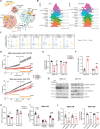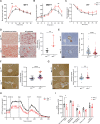Loss of CD98HC phosphorylation by ATM impairs antiporter trafficking and drives glutamate toxicity in Ataxia telangiectasia
- PMID: 40456742
- PMCID: PMC12130354
- DOI: 10.1038/s41467-025-60304-4
Loss of CD98HC phosphorylation by ATM impairs antiporter trafficking and drives glutamate toxicity in Ataxia telangiectasia
Abstract
Ataxia-telangiectasia is a rare genetic disorder characterized by neurological defects, immunodeficiency, cancer predisposition, radiosensitivity, decreased blood vessel integrity, and diabetes. ATM, the protein mutated in Ataxia-telangiectasia, responds to DNA damage and oxidative stress, but its functional relationship to the progressive clinical manifestation of this disorder is not understood. CD98HC chaperones cystine/glutamate and cationic/neutral amino acid antiporters to the cell membrane, and CD98HC phosphorylation by ATM accelerates membrane localization to acutely increase amino acid transport. Loss of ATM impacts tissues reliant on heterodimeric amino acid transporters relevant to Ataxia-telangiectasia phenotypes, such as endothelial cells (telangiectasia) and pancreatic α-cells (fatty liver and diabetes), with toxic glutamate accumulation. Bypassing the antiporters restores intracellular metabolic balance in ATM-deficient cells and mouse models. These findings provide insight into the long-known benefits of N-acetyl cysteine in Ataxia-telangiectasia cells beyond oxidative stress through removing glutamate excess by producing glutathione.
© 2025. The Author(s).
Conflict of interest statement
Competing interests: The authors declare no competing interests.
Figures







Update of
-
ATM phosphorylation of CD98HC increases antiporter membrane localization and prevents chronic toxic glutamate accumulation in Ataxia telangiectasia.Res Sq [Preprint]. 2024 Sep 5:rs.3.rs-4947457. doi: 10.21203/rs.3.rs-4947457/v1. Res Sq. 2024. Update in: Nat Commun. 2025 Jun 2;16(1):5109. doi: 10.1038/s41467-025-60304-4. PMID: 39281865 Free PMC article. Updated. Preprint.
References
-
- Gatti, R. A. et al. Localization of an Ataxia-telangiectasia gene to chromosome 11q22–23. Nature336, 577–580 (1988). - PubMed
-
- Chun, H. H. & Gatti, R. A. Ataxia–telangiectasia, an evolving phenotype. DNA Repair3, 10.1016/j.dnarep.2004.04.010 (2004). - PubMed
-
- Paull, T. T. & Paull, T. T. Mechanisms of ATM activation. Annu. Rev. Biochem.84, 10.1146/annurev-biochem-060614-034335 (2015). - PubMed
MeSH terms
Substances
Grants and funding
LinkOut - more resources
Full Text Sources
Medical
Research Materials
Miscellaneous

